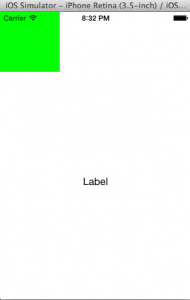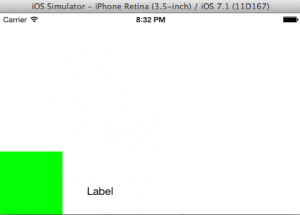UIWindow in iOS
这篇文章,我将分享对UIWindow我所知道的东西。
keyWindow
一个应用能够有许多UIWindow,“The key window”是其中一个,被设计用来接受键盘和其他与点击无关的事件。一个时间段中,如果只有一个Window,那么他就可能是keyWindow。
调用makeKeyAndVisible或者makeKeyWindow,能够使一个UIWindow变成keyWindow。注意,默认情况下,UIWindow是隐藏的。所以调用makeKeyAndVisible,即使一个UIWindow变成了keyWindow,又把它的hidden属性设为NO。
UIWindow is always portrait
在application:didFinishLaunchingWithOptions:中增加以下代码:
UIView *view = [[UIView alloc] initWithFrame:CGRectMake(, , , )];
view.backgroundColor = [UIColor greenColor];
view.autoresizingMask = UIViewAutoresizingFlexibleRightMargin | UIViewAutoresizingFlexibleBottomMargin;
[self.window addSubview:view];
view.layer.zPosition = FLT_MAX;
接着,旋转模拟器或者设备,你将会看到绿色视图总在坐标点{0, 0}。


UIWindow’s的坐标系统总是在竖直方向,旋转是通过设置根控制器的位移。所以,自从iOS4开始,应用建议有根控制器。
Keyboard is a window
注意,UIApplication有一个“windows”的实例化方法。
The app’s visible and hidden windows. (read-only)
This property contains the UIWindow objects currently associated with the app. This list does not include windows created and managed by the system, such as the window used to display the status bar.
你能够获取keyboardwindow通过遍历windows array。摘录于SVProgressHUD中得代码。注意,当keyboard显示出来时,window array中包含一种UITextEffectsWindow类型的window。
- (CGFloat)visibleKeyboardHeight {
UIWindow *keyboardWindow = nil;
for (UIWindow *testWindow in [[UIApplication sharedApplication] windows]) {
if(![[testWindow class] isEqual:[UIWindow class]]) {
keyboardWindow = testWindow;
break;
}
}
for (__strong UIView *possibleKeyboard in [keyboardWindow subviews]) {
if([possibleKeyboard isKindOfClass:NSClassFromString(@"UIPeripheralHostView")] || [possibleKeyboard isKindOfClass:NSClassFromString(@"UIKeyboard")])
return possibleKeyboard.bounds.size.height;
}
return ;
}
之前说过,UIWindow的坐标系统总是横屏的,Keyboard也是一个window,所以不管设备是的怎么样的方向,他的frame总是 (0 0; 320 480)。当你旋转设备时,系统发送一个旋转位移消息给keyboard window。
设备旋转到竖屏:
<UITextEffectsWindow: 0x8e3ecc0; frame = ( ; ); opaque = NO; gestureRecognizers = <NSArray: 0x8e3f240>; layer = <UIWindowLayer: 0x8e3ee40>>
设备旋转到横屏:
<UITextEffectsWindow: 0x8e3ecc0; frame = ( ; ); transform = [, , -, , -, ]; opaque = NO; gestureRecognizers = <NSArray: 0x8e3f240>; layer = <UIWindowLayer: 0x8e3ee40>>
Notification
如果你注册了UIKeyboardWillShowNotification,你能够确认的是:
[[NSNotificationCenter defaultCenter] addObserverForName:UIKeyboardWillShowNotification object:nil queue:nil usingBlock:^(NSNotification *note) {
NSLog(@"%@", note);
}];
设备旋转到竖屏:
UIKeyboardFrameEndUserInfoKey = “NSRect: {{0, 264}, {320, 216}}”;
设备旋转到横屏:
UIKeyboardFrameEndUserInfoKey = “NSRect: {{0, 0}, {162, 480}}”;
所以,在你UIKeyboardWillShowNotification接受后,你应该把他转变成你View的坐标系统。代码摘录于Keyboard “WillShow” and “WillHide” vs. Rotation。
- (void) keyboardWillShow:(NSNotification *)aNotification
{
CGRect keyboardFrame = [[[aNotification userInfo] objectForKey:UIKeyboardFrameBeginUserInfoKey] CGRectValue];
CGRect convertedFrame = [self.view convertRect:keyboardFrame fromView:self.view.window]; ......
/* Do whatever you want now with the new frame.
* The width and height will actually be correct now
*/
......
}
Statusbar is a window
之前说过,windows array不包含the statusbar window,the statusbar window是UIStatusBarWindow类型的,你能够通过以下代码获取。
- (UIWindow *)statusWindow
{
NSString *statusBarString = [NSString stringWithFormat:@"_statusBarWindow"];
return [[UIApplication sharedApplication] valueForKey:statusBarString];
}
就像 the keyboard window, the status bar的大小不会改变,当你旋转屏幕,系统会将旋转消息发送给状态栏。
设备旋转到竖屏:
<UIStatusBarWindow: 0x8f61e30; frame = ( ; ); gestureRecognizers = <NSArray: 0x8f62e40>; layer = <UIWindowLayer: 0x8f620d0>>
设备旋转到横屏:
<UIStatusBarWindow: 0x8f61e30; frame = ( ; ); transform = [, , -, , , ]; gestureRecognizers = <NSArray: 0x8f62e40>; layer = <UIWindowLayer: 0x8f620d0>>
statusBarFrame
UIApplication有一个属性,叫statusBarFrame,是在竖屏坐标系统下的。
CGRect rect = [UIApplication sharedApplication].statusBarFrame;
NSLog(@"statusBarFrame %@", NSStringFromCGRect(rect));
设备旋转到竖屏:
statusBarFrame {{0, 0}, {320, 20}}
设备旋转到横屏:
statusBarFrame {{300, 0}, {20, 480}}
如果你仅仅想获取状态栏高度,而不管设备方向,你能通过以下方式获取:
float statusBarHeight = MIN([UIApplication sharedApplication].statusBarFrame.size.height, [UIApplication sharedApplication].statusBarFrame.size.width);
Notification
当设备旋转,系统发送通知UIApplicationWillChangeStatusBarFrameNotification和UIApplicationDidChangeStatusBarFrameNotification。
让我们来看,接受UIApplicationDidChangeStatusBarFrameNotification后处理。
[[NSNotificationCenter defaultCenter] addObserverForName:UIApplicationWillChangeStatusBarFrameNotification object:nil queue:nil usingBlock:^(NSNotification *note) {
NSLog(@"%@", note);
}];
[[NSNotificationCenter defaultCenter] addObserverForName:UIApplicationDidChangeStatusBarFrameNotification object:nil queue:nil usingBlock:^(NSNotification *note) {
NSLog(@"%@", note);
}];
How to create alert view
有两种方式创建alertView.
Don’t use rootViewController approach
像OLGhostAlertView,SVProgressHUD,WYPopoverController,MTStatusBarOverlay,这样的第三方库,不使用rootViewController。他们创建新window(MTStatusBarOverlay)或者使用存在的UIWindow,他们直接在window上添加子视图。所以他们通过接受UIApplicationDidChangeStatusBarOrientationNotification和UIApplicationWillChangeStatusBarFrameNotification来处理视图方向的。
处理大妈如下,摘录于SVProgressHUD。方法是手动获取屏幕方向并且发送一个 rotation transform 给他的视图。
- (void)handleOrientationChange:(NSNotification *)note
{
UIInterfaceOrientation orientation = [[UIApplication sharedApplication] statusBarOrientation]; CGRect orientationFrame = [UIScreen mainScreen].bounds;
CGRect statusBarFrame = [UIApplication sharedApplication].statusBarFrame; if(UIInterfaceOrientationIsLandscape(orientation)) {
float temp = orientationFrame.size.width;
orientationFrame.size.width = orientationFrame.size.height;
orientationFrame.size.height = temp; temp = statusBarFrame.size.width;
statusBarFrame.size.width = statusBarFrame.size.height;
statusBarFrame.size.height = temp;
} switch (orientation) {
case UIInterfaceOrientationPortraitUpsideDown:
rotateAngle = M_PI; break;
case UIInterfaceOrientationLandscapeLeft:
rotateAngle = -M_PI/2.0f; break;
case UIInterfaceOrientationLandscapeRight:
rotateAngle = M_PI/2.0f; break;
default: // as UIInterfaceOrientationPortrait
rotateAngle = 0.0; break;
} }
How to add view to existing window
第三方库都有他们的在windows上添加视图的方法。
SVProgressHUD 是在最前面的window上添加视图的。
if(!self.overlayView.superview){
NSEnumerator *frontToBackWindows = [[[UIApplication sharedApplication]windows]reverseObjectEnumerator];
for (UIWindow *window in frontToBackWindows)
if (window.windowLevel == UIWindowLevelNormal) {
[window addSubview:self.overlayView];
break;
}
}
How the OS creates AlertView
在WWDC 2014 Session 228,“A Look Inside Presentation Controllers”,他们说:
Behind the scenes, the framework creates a window on your app’s behalf, but this predates iOS window rotation behavior, so this window is technically still in portrait. We then add the action sheet to that window and mimic the transform hierarchy of the presenting view to get into the right orientation.
Use rootViewController approach
一些第三方库,像FLEX,SIAlertView...他们创建一个新window,并且将根控制器赋予给window。这种方式下,设备方向旋转发送给了rootViewController,他们在根控制器上添加视图。添加视图和控制设备方向的代码都在控制器中。
代码摘抄于FLEXViewExplorerViewController:
- (NSUInteger)supportedInterfaceOrientations
{
UIViewController *viewControllerToAsk = [self viewControllerForStatusBarAndOrientationProperties];
NSUInteger supportedOrientations = [FLEXUtility infoPlistSupportedInterfaceOrientationsMask];
if (viewControllerToAsk && viewControllerToAsk != self) {
supportedOrientations = [viewControllerToAsk supportedInterfaceOrientations];
} // The UIViewController docs state that this method must not return zero.
// If we weren't able to get a valid value for the supported interface orientations, default to all supported.
if (supportedOrientations == ) {
supportedOrientations = UIInterfaceOrientationMaskAll;
} return supportedOrientations;
} - (BOOL)shouldAutorotate
{
UIViewController *viewControllerToAsk = [self viewControllerForStatusBarAndOrientationProperties];
BOOL shouldAutorotate = YES;
if (viewControllerToAsk && viewControllerToAsk != self) {
shouldAutorotate = [viewControllerToAsk shouldAutorotate];
}
return shouldAutorotate;
} - (void)willRotateToInterfaceOrientation:(UIInterfaceOrientation)toInterfaceOrientation duration:(NSTimeInterval)duration
{
[...]
} - (void)didRotateFromInterfaceOrientation:(UIInterfaceOrientation)fromInterfaceOrientation
{
[...]
}
因为FLEX创建了新Window,Window必须询问app原始的Window才能获取旋转消息。注意infoPlistSupportedInterfaceOrientationsMask和viewControllerForStatusBarAndOrientationProperties两个属性。你能够从中学到很多。
UIWindow is a UIView
因为UIWindow是UIView的子类,你能够想UIView一样对UIWindow做很多事情。
例如,FLEX重写了pointInside:withEvent: to,用来拦截它的toolbar上的点击。
- (BOOL)pointInside:(CGPoint)point withEvent:(UIEvent *)event
{
BOOL pointInside = NO;
if ([self.eventDelegate shouldHandleTouchAtPoint:point]) {
pointInside = [super pointInside:point withEvent:event];
}
return pointInside;
}
UIWindow in iOS 8
在iOS8,苹果引入了Size Classes,并且“旋转是一种动画式的视图边界变化”。并且UIWindow能够获取屏幕旋转通知。
在WWDC 2014 Session 216,《Building Adaptive Apps with UIKit》
Trait Environments are a new protocol that are able to return their current Trait Collection, and these include Screens, Windows, View Controllers, and also Views. All of these are able to return their current Trait Collection to you to use to determine how your interface should be laid out.
UIWindow in iOS的更多相关文章
- [iOS基础控件 - 6.10.7] UIWindow
A.UIWindow概念 1.继承UIView,是一种特殊的UIView 2.通常一个APP只有一个UIWindow 3.iOS程序启动后,创建的第一个视图就是UIWindow 4.没有UIWindo ...
- iOS开发之UIWindow
1.概述 UIWindow是一种特殊的UIView,通常在一个app中只会有一个UIWindow. iOS程序启动完毕后,创建的第一个视图控件就是UIWindow,接着创建控制器的view,最后将控制 ...
- iOS.UI.UIWindow
UIWindow 1. UIWindow 2. UIWindow的使用场景 2.1 额外添加的Window需要手动进行旋转 最近有遇到一个UIWindow的使用场景:在ApplicationDeleg ...
- AJ学IOS(22)UI之UIApplicationDelegate和UIWindow
AJ分享,必须精品 UIApplicationDelegate 每次新建完项目,都有个带有“AppDelegate”字眼的类,它就是UIApplication的代理 NYAppDelegate默认已经 ...
- 你真的了解UIWindow吗?
一:首先查看一下关于UIWindow的定义 NS_CLASS_AVAILABLE_IOS(2_0) @interface UIWindow : UIView //window的屏幕,默认是 [UISc ...
- 关于UIWindow(转)
(原文出自:http://www.cnblogs.com/wendingding/p/3770052.html,特别感谢) 一:[[UIScreen mainScreen] bounds] 和[UIS ...
- iOS开发之App启动原理
iOS程序的启动过程 程序启动的完整过程大致步骤如下: 1.main函数 2.UIApplicationMain * 创建UIApplication对象 * 创建UIApplication的deleg ...
- iOS UIKit:view
@import url(http://i.cnblogs.com/Load.ashx?type=style&file=SyntaxHighlighter.css); @import url(/ ...
- iOS Multiview Applications
@import url(http://i.cnblogs.com/Load.ashx?type=style&file=SyntaxHighlighter.css); @import url(/ ...
随机推荐
- CSharp命名风格
1.大小写约定 为了区分一个标识符中的多个单词,把标识符中的每个单词的首字母大写.不要用下划线来区分单词,或者在标识符中任何地方使用下划线,有两种方式适合大写标识符的字母: PascalCasing( ...
- Python代码分析工具之dis模块
转自:http://hi.baidu.com/tinyweb/item/923d012e8146d00872863ec0 ,格式调整过. 代码分析不是一个新的话题,代码分析重要性的判断比较主观,不同 ...
- hdu 2025
水题 AC代码: #include <iostream> using namespace std; int main() { char a[100],*p; int max,i; whil ...
- Xcode使用xib拖线时出现: could not insert new outlet connection
解决方法: 1.在新建类的时候没有选择将这个类加入到对应的"Target"中. 2.重新将文件加入项目 操作步骤就是选中出问题的.m和.h文件,点删除键,然后选"Remo ...
- C#操作iframe
<iframe id="cl" name="clf" src="xianshi.aspx" runat="server&qu ...
- uva 12626 - I ❤ Pizza
#include <iostream> #include <cstdio> #include <string> #include <algorithm> ...
- Selinux 禁用
Selinux是对于强制访问控制的实现,在这种访问控制体系的限制下,进程只能访问那些在他的任务中所需要文件. 对于新手来说会影响我们的操作.一般情况下是不需要的,所以禁用他,如果需要的情况下,我们可以 ...
- 漫谈项目设计&重构&性能优化
重构的好处:重构能够改进软件设计,随着项目需求的变更,项目体积的变大早已与最初的设计大相径庭,代码结构变得凌乱.复杂,如果不进行重构,则很难添加新的功能. 1.使项目代码更容易理解很多情况下是由于项目 ...
- JavaWeb学习笔记--3.JavaBean
JavaBean 是一种JAVA语言写成的可重用组件.为写成JavaBean,类必须是具体的和公共的,并且具有无参数的构造器.JavaBean 通过提供符合一致性设计模式的公共方法将内部域暴露成员属性 ...
- cf D. Dima and Trap Graph
http://codeforces.com/contest/366/problem/D 遍历下界,然后用二分求上界,然后用dfs去判断是否可以. #include <cstdio> #in ...
